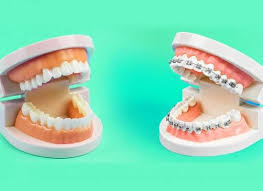Invisalign vs Traditional Braces: Which Suits You Best?
A beautiful, straight smile boosts confidence and enhances your overall appearance. If you’re considering orthodontic treatment, you’ve likely found yourself comparing Invisalign vs Traditional Braces. Both options are effective in straightening teeth, but they differ in appearance, comfort, cost, and maintenance. To help you decide which suits you best, let’s take a closer look at the advantages, disadvantages, and ideal candidates for each treatment.
Choosing between Invisalign vs Traditional Braces depends on your dental needs, comfort, and lifestyle. Invisalign offers a clear, removable, and modern option, while traditional braces provide reliable results for complex cases. Understanding the differences helps you make the best choice for a healthy, confident smile.

1. Understanding Invisalign and Traditional Braces
Invisalign is a modern orthodontic treatment that uses a series of clear, removable aligners made of medical-grade plastic. These aligners gradually shift your teeth into place without the need for metal brackets or wires.
Traditional braces, on the other hand, use metal brackets, wires, and elastic bands to move teeth over time. They’ve been around for decades and are still considered one of the most reliable orthodontic treatments.
When comparing Invisalign vs Traditional Braces, both methods work effectively, but the experience and results can differ significantly based on your needs and lifestyle.
2. Appearance and Aesthetic Appeal
One of the main reasons people choose Invisalign is its nearly invisible appearance. The clear aligners are discreet and ideal for adults or teens who don’t want visible metal on their teeth.
Traditional braces, though effective, are more noticeable. While there are options like ceramic braces that blend with tooth color, they’re still more visible than Invisalign.
So, in terms of appearance, Invisalign vs Traditional Braces—Invisalign clearly wins for those who value a more subtle, aesthetic solution.
3. Comfort and Convenience
Invisalign aligners are smooth and comfortable, with no sharp edges or wires that can irritate the gums or cheeks. They are removable, allowing you to eat and brush normally.
Traditional braces can cause some discomfort, especially after adjustments, and may make it harder to clean your teeth thoroughly. However, they remain fixed, meaning you don’t have to worry about losing or forgetting to wear them.
When it comes to comfort and daily convenience, Invisalign vs Traditional Braces—Invisalign again stands out for offering a more flexible lifestyle.
4. Treatment Duration and Effectiveness
Treatment time can vary for both options depending on the severity of misalignment. Invisalign typically takes 12 to 18 months, while braces might take 18 to 24 months.
That said, traditional braces are sometimes more effective for complex cases involving severe crowding, rotations, or bite corrections. Invisalign works best for mild to moderate alignment issues.
So, when comparing Invisalign vs Traditional Braces, braces may be better suited for complex dental corrections, while Invisalign is ideal for aesthetic and moderate adjustments.
5. Maintenance and Oral Hygiene
Invisalign aligners can be removed for eating, brushing, and flossing, making oral hygiene easier to maintain. You just need to clean the aligners regularly with special cleaning solutions or mild soap and water.
Braces, however, make cleaning trickier since food particles can get trapped around brackets and wires. Extra care and special tools like interdental brushes are needed to keep your mouth clean.
Therefore, in the battle of Invisalign vs Traditional Braces, Invisalign makes it easier to maintain good oral hygiene.
6. Cost and Affordability
Cost is another key factor. Invisalign tends to be slightly more expensive than traditional braces due to advanced technology and customization. The cost also depends on the complexity of your case, treatment time, and your orthodontist’s experience.
Traditional braces are generally more budget-friendly and are often covered by dental insurance. However, the long-term comfort and convenience of Invisalign may justify its higher price for many patients.
7. Which Option Is Right for You?
Choosing between Invisalign vs Traditional Braces depends on your lifestyle, dental needs, and personal preferences.
If you prefer a nearly invisible, removable, and comfortable option, Invisalign might be the right choice.
If you need a more powerful solution for complex alignment or bite issues, traditional braces could be more effective.
Consult your orthodontist to discuss your goals, budget, and treatment expectations. They can evaluate your case and guide you toward the best option for achieving your dream smile.
Conclusion
When it comes to Invisalign vs Traditional Braces, both offer excellent results in straightening your teeth and improving your smile. Invisalign provides comfort, convenience, and aesthetics, while traditional braces deliver proven effectiveness for even the most complex dental issues. The right choice depends on your unique needs and what you value most—discretion, convenience, or cost-effectiveness. No matter which option you choose, investing in orthodontic treatment is an investment in your confidence and long-term dental health.
We’re a team of expert dentists in Penrith with over 20+ years of experience, providing a wide variety of cosmetic and orthodontic dental services.
Copyright © 2023 Penrith Dentistree | Created by InvoQuest Technologies Pvt. Ltd.
